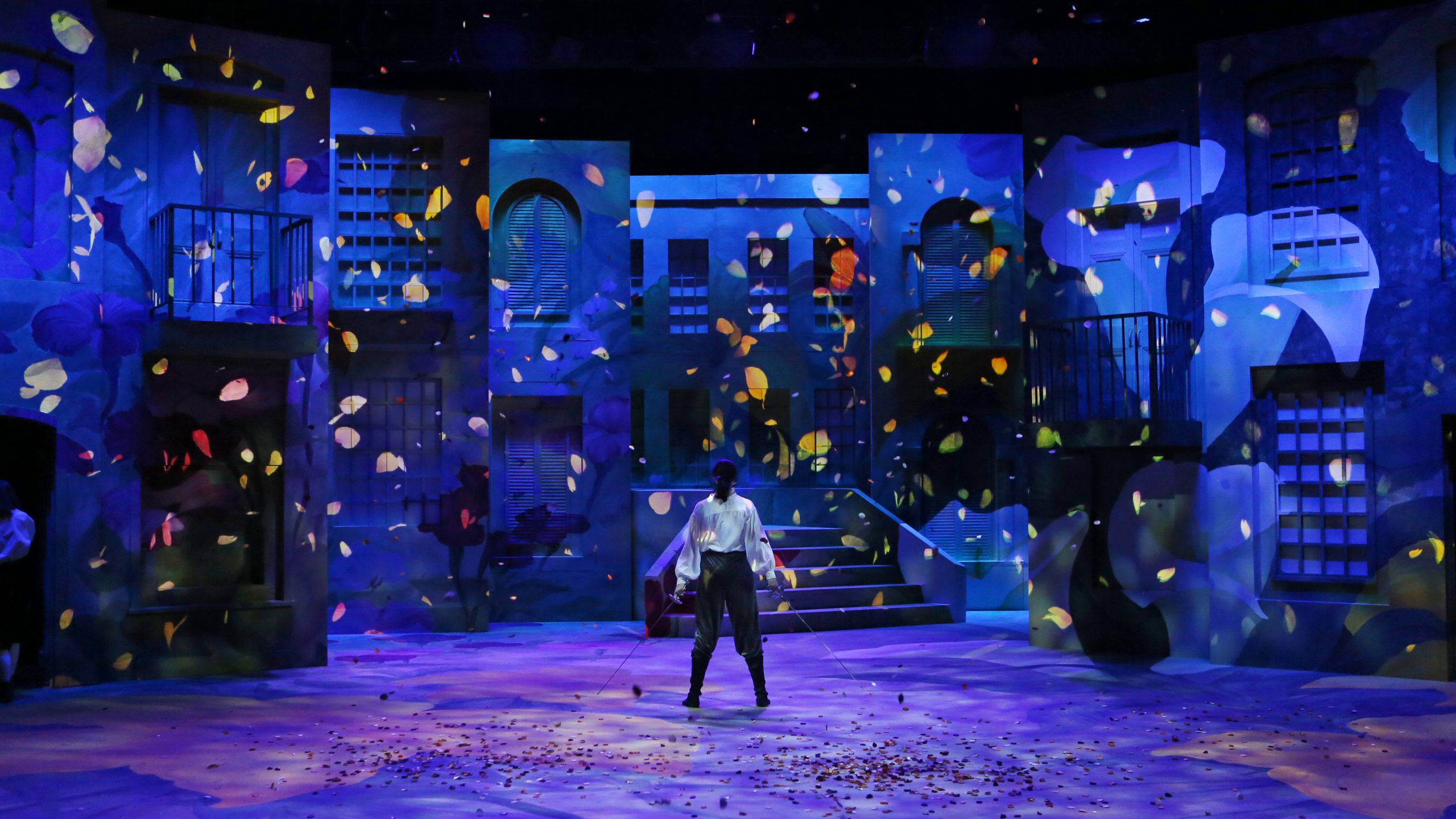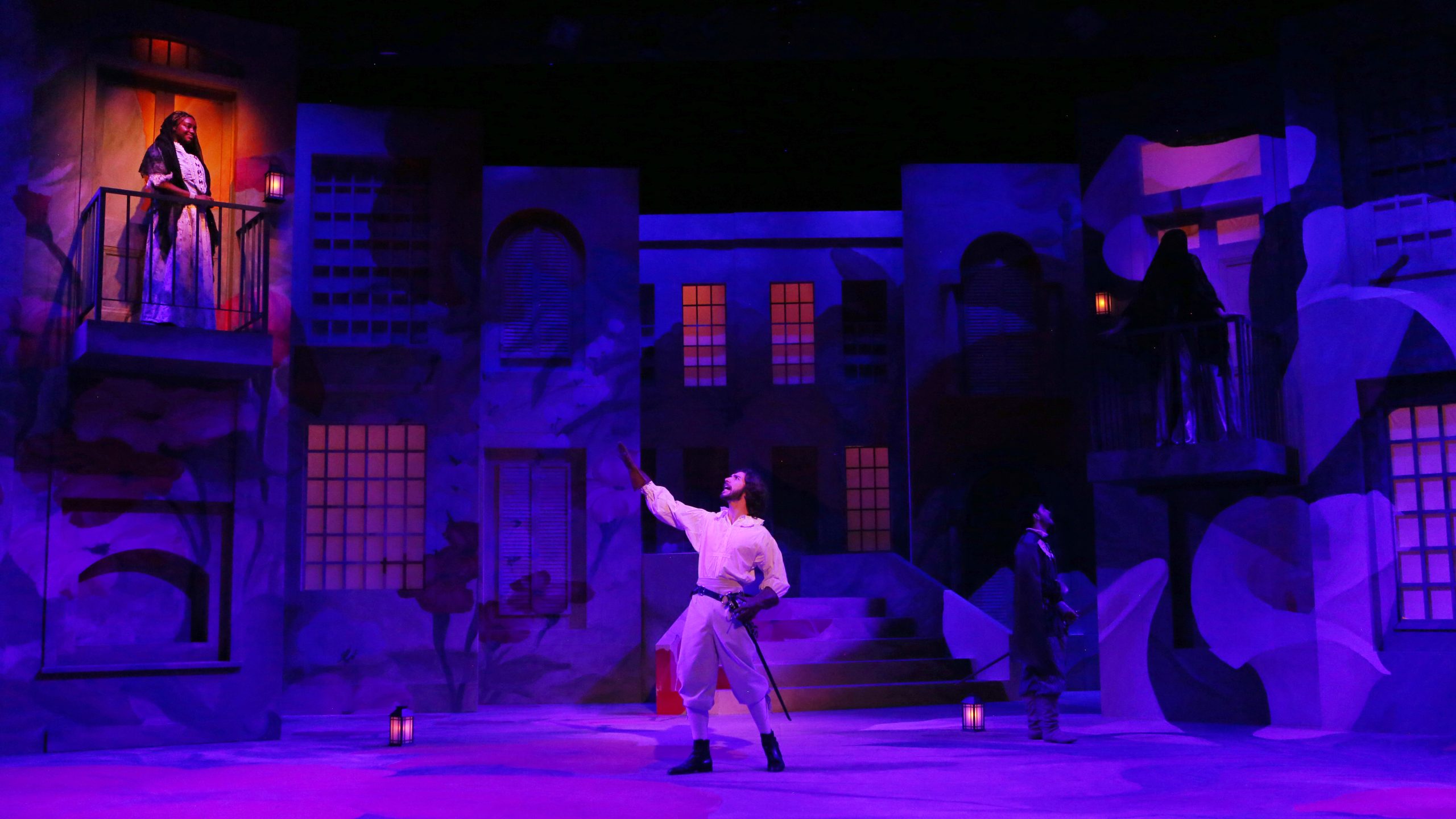“They Crack Open a New World”: Ana Caro’s Courage at Skidmore College By Sarah Grunnah
An interview with Professor Lisa Jackson-Schebetta, director of Skidmore College’s production of The Courage to Right a Woman’s Wrongs [17-19 November, 1-3 December 2023]
Sarah: What was it about The Courage to Right a Woman’s Wrongs that interested you as a director?
Lisa: I have long loved comedias, and have long advocated for doing comedias. I had read Ana Caro’s Valor, agravio y mujer in Spanish and also some of [Teresa] Soufas’ translation when I was in grad school. My dissertation was going to be on Spanish Golden Age theatre, but it ended up being on the Spanish Civil War. This play in particular I was really drawn to because of the story, the verse, the robust characters, the possibility that we could play with gender and surface queerness in the play. And also, the almost unimaginable act at the end when Leonor forgives Juan—the idea that we could believe that somebody could forgive somebody, and step into that grace. Reyn [Ricaford, production dramaturg] and I really felt that they crack open a new world, because, by rights, Leonor should kill Juan—she should—and they are locked in that kind of structure of “We must kill each other,” and then she breaks it. And that power that this woman has, coupled with the story of Ana Caro herself and what we do and don’t know [about her]… I think the play is also really wily. She’s really saying a lot and putting a lot in there that she shouldn’t be able to, maybe, in the moment, and yet is able to, and it really captured my imagination in terms of what a company might be doing when they’re putting it on.
Sarah: How do you reconcile this kind of unsettling ending with the world that we live in today? And what kinds of conversations did you have with the actors and your production team in grappling with this kind of problematic ending? Did your approach to the ending go through a journey in the process?
Lisa: Yes. So I taught [the play] a year ago, and we grappled with it in that history class. And obviously my students are 20 [years old], so they’re like “What?! Why doesn’t she kill him at the end?” and “How could she forgive him?!” and “Why is this just, like, staged patriarchy happening?” And I was like, yeah, let's talk about it. I'll be honest with you, as a director I was like: “Hmm, let’s just rewrite the ending.” But I didn't want to do that, because I wanted to really lean into the difficulty of that ending. Because human beings are difficult, and complex, and have capacities we can’t even imagine. And I do think Caro is rewriting Juan to be something else. I mean, at the end he says: “I will adore you” —adore as adoration, and it’s divine, and it’s beyond love. It’s worshipful. And he never speaks again. That’s really important. So we spent a long time talking about it, because of course the actors came in and they were like: “What?!” Reyn and I really grappled with it this summer, and I was like, I’m going to say we’re going to stage this ending as it was written, so let’s talk about it. Let’s figure out what that means. And we really leaned into the historical moment of the time period, and the legal aspects of gender and marriage and honor, and the idea that honor is contingent on another person. And also the idea that this woman is writing for public playhouses, and that those are not free-for-all spaces where you can do whatever you want because of the different social and cultural and political institutions that are at play. So, yeah, it’s hard. Reyn and I, though, really grappled with this idea that Leonor is more than human by the end. It is as if there is a more-than-human justice that she is seeking to break open, in a world that would trap us in roles that we have to play. So we kept digging into that with the actors, and we kept talking about forgiveness and grace and how difficult that is. We started this play in September, so it also feels really different now [in November], because we looked into the history of Andalusia and we looked into, you know, whether the convivencia has been mythologized or not. There is Alfonso el Sabio. There are moments in which we have this coexistence, or at least glimpses of it, whether in practice it was always that way or not—it never is. We talked a lot about archives and repertoires, and about the histories that we don’t know. So, Nina [Renkert, Lisarda] used the genealogía [a chronicle, published as two volumes and held at the Biblioteca Nacional in Madrid, documenting everything from everyday life to theatre practices, from the first half of the 17th century until c. 1721]. and was really moved by these names we have of actors with nothing else about them. We talked about that, and I was really invested in surfacing the histories that we don’t know as much about. So, one: a lot of people think Spain is just some homogeneous Catholic nation forever and ever and always, since 1492, done. And I was like “No”. No, let’s crack that open. That's a different kind of hegemony that is perpetuated, so we talked about that. Reyn was particularly interested in queer histories, so we spent time talking about queer acts over the summer. I learned a lot about queer histories, and also these histories of perhaps crypto-Jews, or crypto-Muslims, or these other histories that might have been circulating. And, this idea of Sevilla as a port city. So then, one day, I came upon this idea: we’re really leaning into the history, and even though the play is set in Flanders, I really wanted Seville to be present, so I thought— because I really wanted Ana Caro to be present, we decided that we would do a theatre company, of 1620 Seville (or 1610, 1618, somewhere in there) putting on the play. What that allowed us to do is the actors then created characters informed by the history that then played these characters. So that would allow us to play that ending, as it is, with all of the forgiveness and impossibility of it, because sometimes people forgive each other, and sometimes it’s okay, and sometimes it isn’t, but we don’t know. We just agree in this moment to step into the next moment of the unknown together as humans who care about each other. We talked a lot about that. But then, having this company allowed us to surface these queer histories, these different kinds of racial and ethnic histories. So we play the play, and we have a very brief prologue: nobody talks, there’s not a trunk on stage but it is the actors getting ready and we have these foley items that we built based on what they would’ve been in the early 1600s. We have this wind machine, for instance. It’s very cool. And then we play the play, we play the ending. There’s no mouth kiss between Leonor and Don Juan. He goes down with his forehead in her lap, in a sort of Christian, Catholic or any kind of supplicative gesture. And then I was interested in Ribete being either genderfluid or female. But then we have the Ribete-Flora relationship that became really important to us throughout the piece as well, and that’s kind of the last image. So we play the end of the play, and then right before Leonor says her final line, the company comes back in a kind of dream ballet, and they couple off in other ways. So we have possibility and also this love letter to possible worlds beyond which is what I think Caro was writing.
Sarah: The idea of a frame narrative for this play is fascinating. In the dream ballet moment, do we see Leonor and Juan together in your staging at all?
Lisa: No. They break off into the company, actually, and the actor who plays Juan is in a couple with the actor who plays Fernando in the company. They pair off, and then the actor who plays Leonor has decided they are lovers with the actor who plays Estela. So the last image is just Leonor—the actress who plays Leonor on stage saying her line, and then she takes the actress who plays Estela’s hand and leaves. Because what I wanted for Juan and Leonor is that we don’t know. I don’t know what’s going to happen. I know that in that moment, they agree to step into the next moment, but I didn't want to say what that next moment is.
Sarah: Okay, so now let’s take a step back. How do you approach heightened language in your work? And what challenges or opportunities has working on a translated text brought you and your actors?
Lisa: I actually love heightened language because we can always mine the text for what we need. And we talk a lot about, and practice a lot, like “work the text and let the text work you”. And so now we’re in this place [at opening night] of finding ease again. So, that’s really exciting, and I love that because it becomes this container that will hold the actors and will hold the emotion that they can trust. I really believe that having that structure, even though it’s not iambic pentameter—it doesn’t matter, it’s verse—having the structure of the verse and the poetry, they are able to trust that structure and they are wrestling with it, and now it holds them, so they can really listen and respond in a very free way. So I love working on it, particularly with young actors, too, because whatever we’re learning about verse and operative words and antithesis and rhetoric and listening and responding and building and lists and asides and all of that. The asides are super fun, that’s another reason I love comedias and particularly this play: they can apply all of that to commercial text, to contemporary text, to all of that, so that’s been really fun. And we’re in a big space of 300 seats, so, it necessarily asks them to be heightened in their bodies, and to really listen to each other, which I love. And the next time I do a comedia from UCLA’s Diversifying the Classics, I would really love to foreground translation as a lens for our approach to performance. What’s been so fun is that we have a native Spanish speaker from Santiago in the cast, and a couple of actors who speak Spanish as their second language. And so they’ve gone back to the original Spanish and we’ve looked at words and looked at translating. We looked at different meanings of coraje, agraviar, and valor, which have really opened up the nuances of the possibilities for the actors in terms of tactics, objectives, obstacles, and so forth. So that’s been really fun, and also something that I’ve learned that I could do even more of, I think. Even if I don’t have Spanish speakers, I have Spanish, and will always have somebody in the cast, or somebody on my campus, who has Spanish, you know, so we could really look at the nuances of language and the ways in which we can go back to the original language to inform English while simultaneously thinking about all the choices that have been made to create this very cohesive, very actor-friendly, very stageable translation. And we’ve loved having the Spanish in there, because my native speakers and my Spanish-as-second-language speakers have loved to be able to play with that. Some of the people who only have English; they're a little less confident. So we let people choose.
Sarah: I love the duality and the depth that working on translation brings to the process for even these native English speakers. It can be so exciting. On that note—but also outside of thinking about this as strictly a translation—what kinds of discoveries did you make about this play in the process? Was there anything that surprised you? Or any perspectives that changed from when you worked on it over the summer, to opening night?
Lisa: So many things. I do think the play and the historical circumstances of the world in which the play was written and the challenges of the story for our contemporary moment have really brought the cast together, and the company together. We really feel like we’re working on something together, like we’re grappling with something together. I didn’t necessarily expect that we would sort of be bound together through the text so closely, through trying to understand this historical text in this moment in not only intellectual but emotional and soulful ways and the challenge of meeting these characters. I think the hardest character is Juan, in this moment, because he has to say a lot of things. we have a very beautiful human playing Juan and I talked to him about it and I was like “These are hard lines, like, this is hard” and he was like “This is hard” but he said, “I’m not going to betray my character, because I do, I feel that he is struggling as best he can, but at the same time sometimes I don't like him,” and I was like, “Yeah”. But sometimes I don’t like Leonor either, so the biggest discovery we made, as a company was how incredibly human these characters are and how fallible they are and how they disappoint each other, and let each other down, and uplift each other, and save each other, and love each other. We think about even Fernando, like, Fernando, come on, come on, tell Estela, will you just tell her, but he can’t, he won’t, because of this, and that, and the other thing, and so that was really a beautiful discovery to make: just how human they are in their glories, and fallibilities. And that has been really rich. And we found this even with the smaller characters like Lisarda or Godofre. We have a company of fifteen so we have an ensemble, and they have the named characters but we also have like, you know, people who sweep the floor, or people who are arranging flowers, or what have you. But because of this historical frame, they would be the new company members and so they’ve also become such an integral part of the world, which has been really nice. And because I had a period wind machine—come on, I have got to use it.
Sarah: Obviously.
Lisa: So the beginning of the second act—inspired by entremeses, inspired by the format—the ensemble has a whole little act with the wind machine, in the beginning, to bring into the second act so they get some of their own stuff, too. Those were the big discoveries, I would say. And the joy, and the humor. My husband was looking at the poster and he was like “well, it’s a comedy, and that poster doesn’t look like a comedy” and I was like “The genre’s slippery”. It's early 1600s. Sure, it’s got some comedy in it, but also it’s serious. People might kill each other. So that’s been really fun, too, to play those right angles and just be honest.
Sarah: It’s one of my favorite thing about these plays, honestly. That duality of genre of the comedia helps raise the stakes, too, and also humanizes. That’s what we are as humans; we can hold contradictory things in our head even though we’d like not to sometimes.
The interview has been edited slightly for clarity.







No Comments